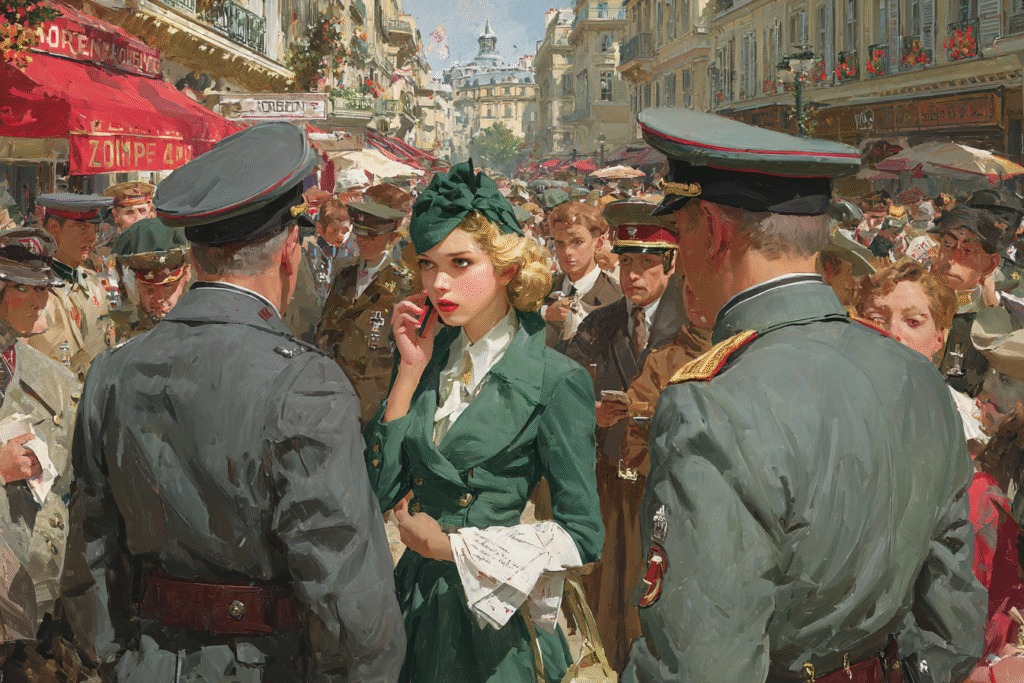
From SRP author Tracy Cooper-Posey:
There’s something spine-tingling about watching a spy drama unfold on screen, where the stakes hinge on the smallest misstep. A word said in the wrong dialect. A glance that lingers too long. A button stitched the British way.
I was flipping through my notes the other day and rediscovered an absolutely riveting piece on how the British Special Operations Executive (SOE) dressed their spies in WWII. Not just dressed, mind you—but tailored, aged, dyed, worn-in, and obsessed over. These outfits were literally life-and-death garments. Because when you parachute into Nazi-occupied France, you better not look like you just walked out of Marks & Spencer.
The SOE trained and dispatched some 1,800 agents into France alone, and those agents had to pass for locals. That meant ditching British tailoring quirks, getting their buttons stitched the “French way” (two parallel lines, not a crisscross), replacing British-brand zippers, and even distressing brand-new clothing until it looked suitably used and ration-era ragged.
At one point, spies were getting French fillings in their teeth and fake tailor slips in their suit jackets. A spy’s shirt could betray him. A “British” stud hole on a detachable collar—vertical, not horizontal—might get him shot. Even shoes had to be French. As one spy discovered the hard way, an elderly woman on a train nearly outed him because she recognized his “lovely English shoes.”
Details. Ridiculously tiny ones.
And yet, they mattered. Deeply.
Which brings me to a confession: I totally get it.
When I moved from Australia to Canada, it wasn’t the big cultural stuff that threw me. It was things like figuring out that “next Tuesday” might mean not this Tuesday coming, but the Tuesday after. Or saying “How ya going?” and being met with blank stares. I spent six weeks with a permanent headache trying to translate English into… still English, just different-flavored.
And that’s in peacetime. No Gestapo looming over my shoulder, just a grumpy barista wondering what on earth I meant by “flat white.”
Imagine, then, having to get it all right—clothes, accent, grooming, luggage contents, the literal angle of a buttonhole—while living undercover. It makes my adaptation hiccups look laughably mild. But the principle is the same: we judge what’s foreign or familiar based on the smallest cues. It’s not always fair, but it’s real.
I remember a WWII film where Cate Blanchett played a spy, and her drop kit included French sanitary pads, because yes, even those were different enough to potentially get you caught. It makes you think about just how fragile disguise is—how easy it is to be found out by a misplaced pleat or a too-shiny shoelace.
So what’s the takeaway? That attention to detail isn’t just a fussy personality trait. It can be a superpower. It can be the difference between being welcomed… or not. Between blending in… or standing out for all the wrong reasons.
Whether you’re a writer trying to build believable worlds, or someone starting life in a new country, or (let’s hope not) a covert operative, the lesson remains the same:
The details matter.
Sometimes they matter more than the big stuff.
Have you ever stumbled—embarrassed yourself or made a complete faux pas—just because of some small detail you didn’t know mattered? (And if you’ve ever moved countries, I know you have a story.) Or—have you read a romance where the heroine got the details wrong and ended up in a heap of trouble? Regency romances are rife with these little traps—tea manners, glove etiquette, the wrong kind of bonnet!
Drop your favorite “oops” moment or fictional disaster in the comments—I’d love to commiserate.

Tracy Cooper-Posey
SRP Author



